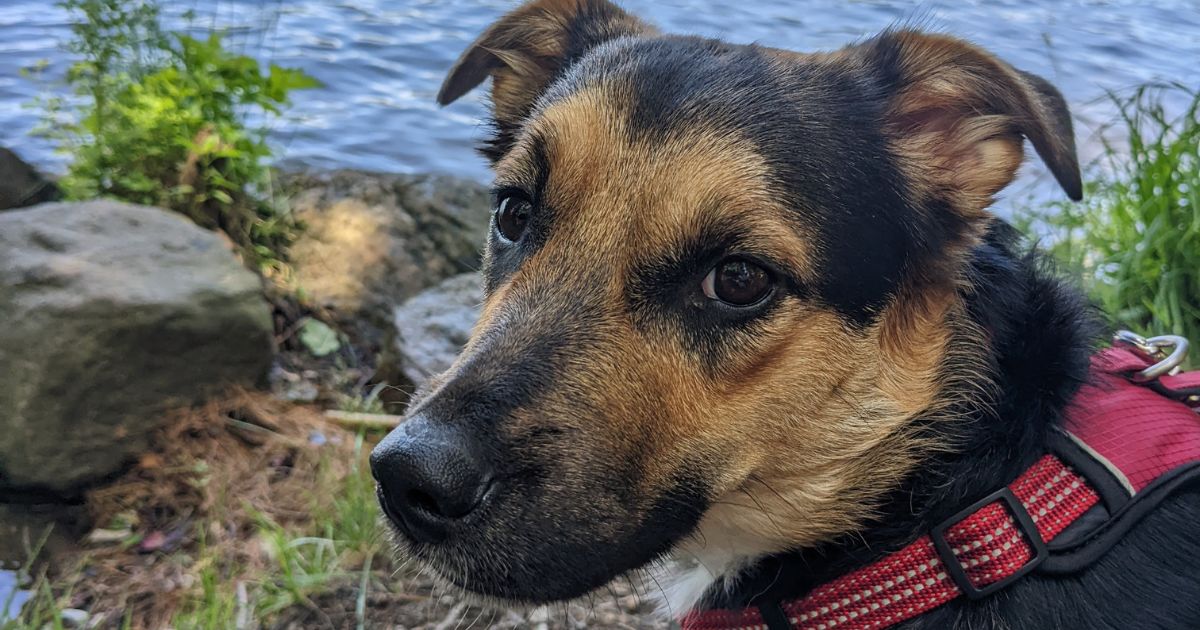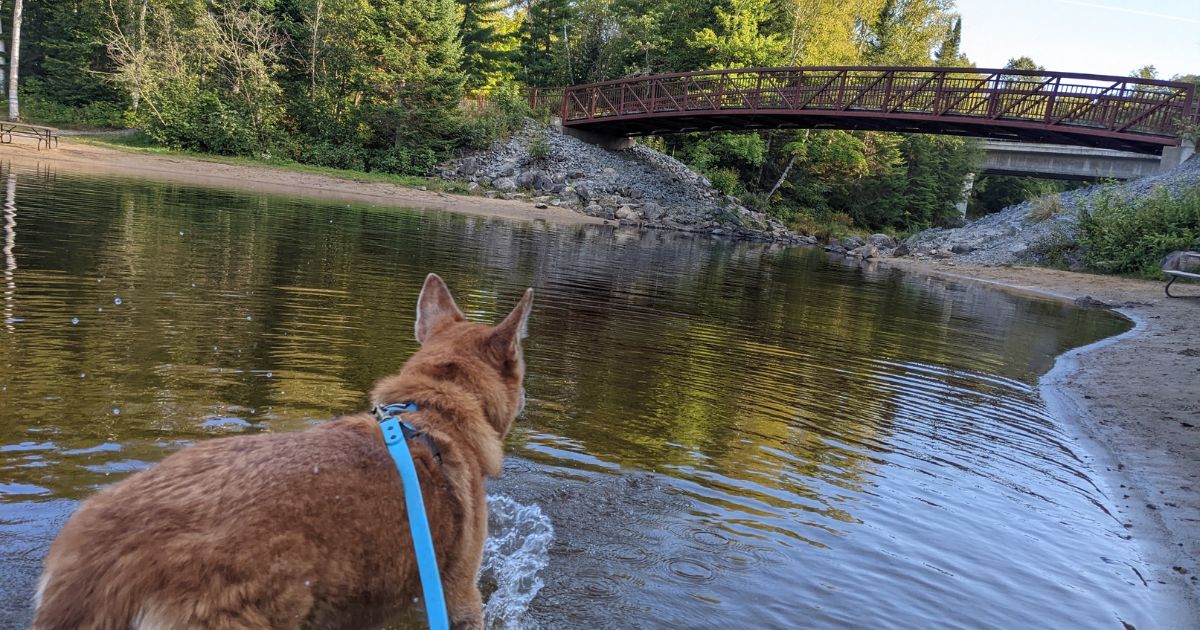How to Spot, Treat, and Prevent Beaver Fever in Dogs
There are many risks we must be aware of when adventuring with our pets. From dangerous trail terrain to fleas and ticks, being aware of the potential risks will allow us to take steps to protect our furry companions.
While there are highly effective products for preventing fleas and ticks, the same can’t be said for beaver fever in dogs.
So, what is beaver fever, and what can we do to keep our dogs safe?
This article will look at everything you need to know about beaver fever and your dog, including the most common symptoms, treatment options, and ways to effectively prevent an infection.
Let’s get started!

What Is Beaver Fever in Dogs?
Let’s start at the beginning – what exactly is beaver fever, and how does infection occur?
Beaver fever is a common name associated with Giardiasis. It’s an intestinal infection caused by a microscopic parasite that humans and our pets can experience.
The parasite exists in two forms. The first form is called a trophozoite and lives in the gut of infected animals. At this stage, it attaches to the intestinal wall of its host, feeds, and multiplies.
The second form is a cystic form. These cysts are passed in an animal’s feces. The infection can then be passed to other animals that eat feces from an infected host or drink contaminated water.
The cystic form of the parasite can survive for several months in ideal conditions, which include water and damp environments.
What are the Symptoms of Beaver Fever?
Dogs that have picked up the Giardia parasite may not show signs or symptoms of infection. This is especially common in otherwise healthy adult dogs.
But even if they don’t show symptoms, they can still pass the parasite to other animals (including humans). This is particularly important to remember if you share your home with a senior dog, a young puppy, or a dog with a compromised immune system.
Some of the more common signs of Giardia in dogs include:
- Vomiting
- Weight-loss
- Dehydration
- Foul-smelling diarrhea
- Greenish, fatty stool
- Stool containing mucus
- Blood in your dog’s stool
- Poor coat appearance
- Lethargy
If you notice any of these beaver fever symptoms in your dog, contact your veterinarian. They will be able to conduct diagnostic testing to determine if the illness is, in fact, Giardia and discuss your options for treatment.
How Long Does It Take for Giardia to Go Away in Dogs?
The good news is that Giardia infections are rarely life-threatening to our dogs. However, it can be more severe in at-risk pups, as mentioned above.
After confirming that Giardia is responsible for your dog’s symptoms, your veterinarian will prescribe antibiotics to treat the infection. The most common antibiotics for the treatment of beaver fever in dogs are fenbendazole and metronidazole.
These antibiotics will need to be administered for anywhere from three to ten days.
Depending on the severity of your dog’s infection, your vet may also recommend dietary changes or fluid therapy.
Two to four weeks after treatment, your dog and any other pets in the house that may have been exposed should be retested to ensure that the beaver fever treatment was effective.

Will Giardia in Dogs Go Away on Its Own?
Many healthy adult dogs will carry the Giardia parasite without any signs or symptoms of infections. While your dog may not appear sick, treatment is necessary before they will be free of the parasite.
Without antibiotics, the infection may continue to grow. In time, even a dog with no symptoms may eventually develop signs of illness.
Likewise, an infected dog may appear to get better on their own. But without medication, flare-ups may continue in the future.
If you recognize that your dog is feeling ill, veterinary assistance in addressing the parasite appropriately is the best option for you, your dog, and any other pets in your home.
Are There Effective Home Remedies for Giardia in Dogs?
No. While we understand the desire to find a natural remedy, where possible, no natural methods have been proven effective.
Prescription medication is the only guaranteed way to treat beaver fever in dogs.
Is Giardia Contagious from Dogs to Humans?
There are seven different genotypes of Giardiasis, identified as genotypes A through G. Scientists have determined that dogs are susceptible to genotypes A, B, C, and D. Humans, however, are only affected by genotypes A and B.
Cats are only vulnerable to infections from genotypes A and F.
Unfortunately, you can’t identify which genotype your dog has contracted by simply witnessing the symptoms they present.
For this reason, you should treat every case of Giardia in dogs as if it could be transmissible to humans.
Always wash your hands after handling your dog or cleaning up feces. It’s also important to remember that our pets like to clean themselves. While we are not against “kisses,” avoiding that type of interaction is recommended until you can confirm that the treatment has been effective.
How Do I Clean My House After My Dog Has Giardia?
If your dog is being treated for a Giardia infection, you must stay on top of cleaning the home both inside and out.
This will help to prevent reinfection and give the medication time to work. It will also prevent the parasites from infecting others in your home, both humans and pets.
Any poop should be bagged up and disposed of immediately after your dog goes to the bathroom. Treat your yard like a trail or dog park, carrying poop bags and practicing poop and scoop rules.
Hard surfaces like your pet’s crate or tile floors can be washed with soap and water or a household disinfectant. If using a disinfectant product, follow the directions on the label.
Carpets, rugs, throw pillows, and bedding can be more challenging to clean. If an item can be machine washed, this is the easiest and most effective method (see the point below regarding cleaning your dog’s bedding).
Otherwise, you can use a carpet cleaning product to wash and disinfect these surfaces, allowing them to dry thoroughly before giving your dog access to the space.
Your dog’s dishes and dishwasher-safe toys can be disinfected in the dishwasher or submerged in boiling water for at least one full minute before allowing them to try.
How Do You Disinfect a Dog Bed for Giardia?
Regularly washing and disinfecting your dog’s bedding during and after treatment is essential in addressing a Giardia infection.
Wash the bedding in the washing machine using hot water and your laundry detergent of choice. Place the bedding in the dryer on the highest heat setting for 30 minutes.
If you don’t have access to a dryer, you can also hang bedding in direct sunlight to air dry.

5 Tips to Prevent Beaver Fever in Dogs
Bring Plenty of Fresh, Clean Water
When hiking with your dogs, pack plenty of fresh, clean water for you and your pup. Carrying this water with you on your adventure reduces the likelihood of your dog taking a drink from an infected water source.
If you are backpacking or heading out on a multi-day trip, boil your water for 1 minute before consuming it or pack an effective filter or water treatment product.
Be sure to read the label of any products carefully when shopping to ensure that they are proven to remove Giardia cysts from water.
Take Regular Water Breaks
Bringing water on your trip is great, but it isn’t going to help if you don’t prioritize keeping your dog hydrated.
Take regular water breaks, especially if you are hiking in a location with water access or following a rainy day with puddles in the area. If thirsty, your dog will seek the nearest available water source.
Steer Clear of Feces
Supervise your dog when you’re out on the trails. If you notice any feces along the way, prevent your dog from checking it out. Even sniffing contaminated feces can lead to transmission if they make contact, then lick the residue off their nose or paws.
Clean Up After Outdoor Adventures
The Giardia parasite can thrive for several months in damp soil. This means your dog may come in contact while digging, running through mud puddles, or simply “enjoying the great outdoors.”
One of the most overlooked ways to prevent beaver fever in dogs is to take time to clean your pup during and after your trips.
Plan to clean up your pup before allowing them to start cleaning themselves. This includes washing dirty puppy paws and wiping down their coat to remove any contaminated dirt or soil.
When camping with your dog or heading out on multi-day hiking trips, take time to clean up periodically, with a final clean-up after heading home again.
Thoroughly Clean and Dry Gear After Each Trip
When your adventure is over, take the time to fully clean all gear that you and your dog used on your trip, including bedding, clothing, harnesses, and towels.
Ensure these items are completely dry before packing them away for your next trip.

Have you previously heard about the risks of beaver fever in dogs? If so, what steps do you take to keep your family safe? We invite you to share your tips and tricks in the comments!
